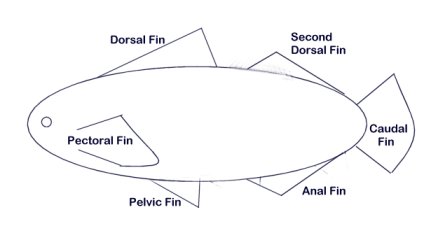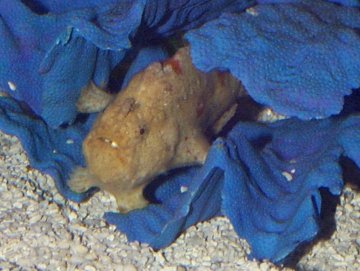
Fins are a type of appendage -- that is they project or stick out from the major axis of the body. All true fish have fins. Fins, like other vertebrate appendages, may serve a variety of functions, and some types of fish can even be identified by the type of fin they have. In this ZooPax, we will look at some of the different types and arrangements of fins that can be seen in the fish at the Fort Worth Zoo.
The fins of a bony fish (Vertebrate Class Osteichthyes) have the general pattern below:

The pectoral and pelvic fins are paired. The two dorsal fins may be fused into a single dorsal fin. The anal fin starts just behind the anus, so the position of this fin can be used to mark the end of the body or the beginning of the tail. Look at the picture of the carp below and identify the fins in the diagram.
Notice that the fins are supported by a
fan or row of delicate bones -- the fin rays. This is the typical structure
of a "ray-finned" bony fish (AKA Actinopterygians), to which group most
of the bony fish belong. Let's look first at another way of supporting
the fins, which is seen in lungfish. Lungfish are members of a group of
fish called the fleshy-finned fish, or Sarcopterygians. ["Actino" means
"ray" and "Sarco" means "flesh". So what does the "pterygian" in these
names mean?]
Now we will look at some different fin arrangements among the ray-finned fish. Some fish have the pectoral and pelvic fins well separated, while in others, the pelvic fins may be right under or even a little in front of the pectoral fins. Some fish may have one or more types of fin missing.
 The
fish at the left is a bichir (pronounced "biker") or Polypterus. These
are considered to be fairly primitive bony fish, since they have some of
the features of sharks, e.g. a cartilage skeleton and a spiral fold in
the intestine. However, the fish is also somewhat similar to a lungfish
because the pectoral and pelvic fins have a fleshy
base. Does it also have lungs? Look at the WhoZoo
Bichir Page to find out. Look at the structure of the dorsal
fin on this fish. How is it different from the dorsal fin of the carp
discussed above? Note that the pelvic and pectoral fins are well separated.
The
fish at the left is a bichir (pronounced "biker") or Polypterus. These
are considered to be fairly primitive bony fish, since they have some of
the features of sharks, e.g. a cartilage skeleton and a spiral fold in
the intestine. However, the fish is also somewhat similar to a lungfish
because the pectoral and pelvic fins have a fleshy
base. Does it also have lungs? Look at the WhoZoo
Bichir Page to find out. Look at the structure of the dorsal
fin on this fish. How is it different from the dorsal fin of the carp
discussed above? Note that the pelvic and pectoral fins are well separated.
Look at the two fish below. The fish on
the left is a Yellow-finned Chalceus and the fish on the right is a Demon
Cichlid. Find the pelvic, dorsal and anal fins of these two fish. How are
they different. The Chalceus is related to Tetras and Piranhas (the group
that contains all three is called the Characins), but the Cichlids are
classified with a different group. There are many species of cichlids at
the Fort Worth Zoo. Take a look at the fins on several others and see if
this arrangement on the Demon Cichlid is typical of cichlids or if it is
just a peculiarity of the Demon cichlid. Check out the Tetras and the Piranhas.
Does their fin arrangment resemble that of the Chalceus? Could you use
the fin arrangement to help you distinguish between a Characin and a Cichlid?
(Of course there are many OTHER types of ray-finned fish -- this is a very
large successful group.)
Yellow-finned Chalceus |
Demon Cichlid |
|
|
|
|
This sturgeon is another example of a bony fish with some primitive characteristics. Which fin seems to be missing in this fish? Compare the caudal fin, pectoral and pelvic fins with those of this bamboo shark and with this red drum. Which of the two fish is the sturgeon most like? |

Angler Fish Both the pectoral and pelvic fins of the Angler Fish form stout leglike structures that the fish appears to use to brace itself in its hiding place. What do the other fins of this fish look like? |
|
In the Moray Eel, the lateral
fins are entirely gone, while the elongated dorsal and anal fins are both
fused with the caudal fin.
Moray Eel |
In the Bird Wrasse,
on the other hand, the pectoral fins are the exclusive means of locomotion,
and the fish flies through the water on tiny "wings".

Bird Wrasse |
|
|
|